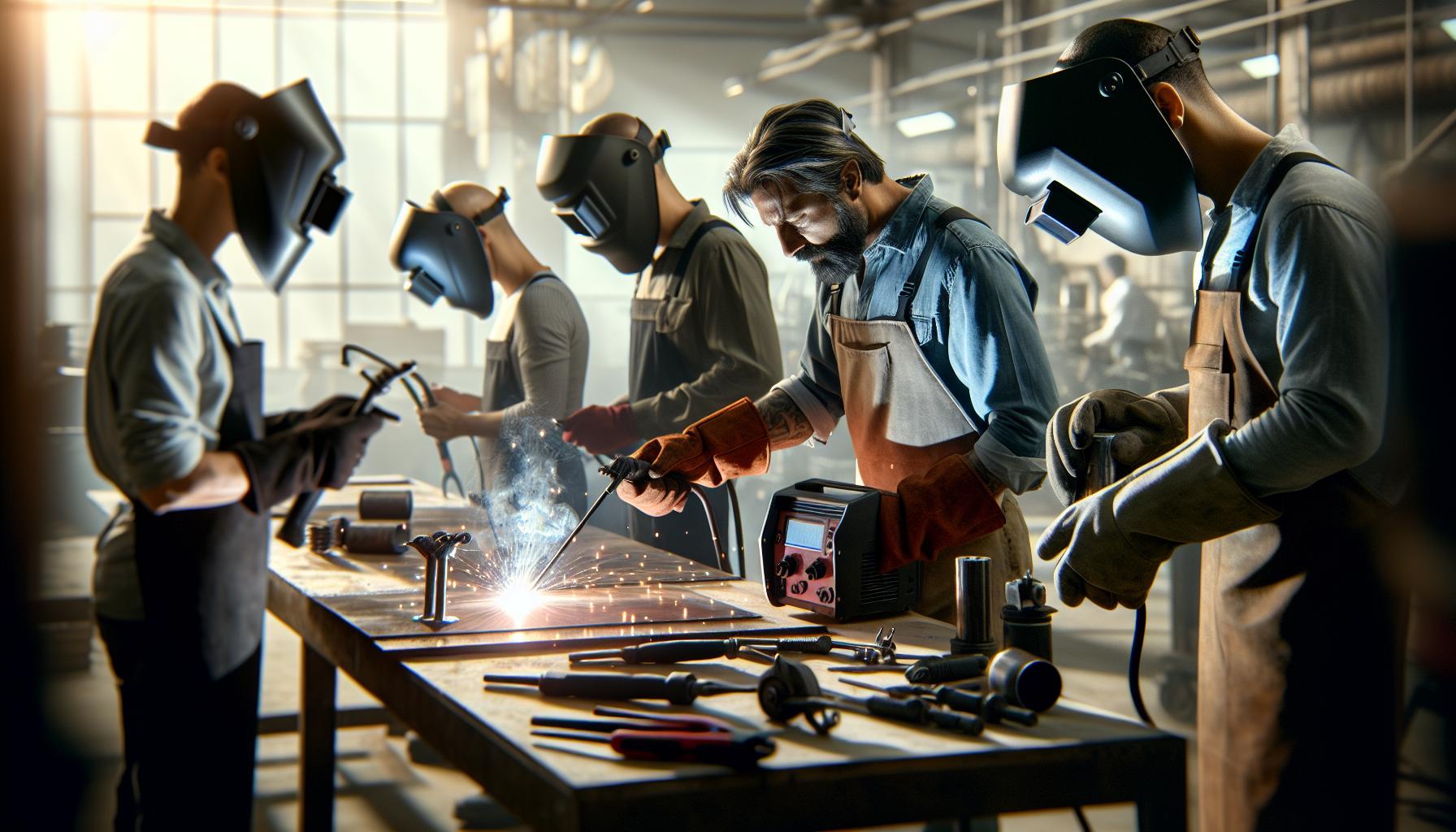Welding is not just a skill; it’s a gateway to a rewarding career that is in high demand across various industries. With the right training and certification, you can transform a passion for working with metal into a sustainable livelihood in as little as six months. This article will guide you through the essential steps to become a certified welder, exploring crucial techniques like MIG, TIG, stick, and flux core welding. You’ll learn about the various materials, including steel and aluminum, and gain insights into necessary equipment and safety protocols. Whether you’re a beginner wanting to launch a new career or an experienced worker aiming to enhance your credentials, this pathway not only secures job opportunities but also contributes to your professional growth. Dive in to discover the steps to achieving your certification and positioning yourself for success in this dynamic field.
Essential Skills for Aspiring Welders
To thrive in the welding industry, aspiring welders must cultivate a diverse set of skills that extend beyond the basic techniques of welding. Strong hand-eye coordination is vital, allowing welders to manipulate equipment with precision. Moreover, a solid understanding of different materials, such as aluminum and various steels, enables welders to select the appropriate techniques-be it MIG, TIG, stick, or flux core welding-tailored to specific project requirements.
Equally important is the ability to read blueprints and technical drawings. This skill ensures that welders can interpret specifications accurately, which is crucial for assembling metal structures correctly. Familiarity with welding symbols and safety regulations is essential as well; these elements safeguard not only the welder’s health but also the integrity of the work produced.
Hands-on practice is indispensable in welding education. Participating in workshops and labs, as found in dedicated training programs, allows students to apply theoretical knowledge in real-world scenarios. This experiential learning enhances proficiency and builds confidence, equipping newcomers with the expertise they need to excel in the field.
In addition to technical skills, soft skills such as teamwork and communication are vital. Welders often collaborate with engineers and other tradespeople, making the ability to articulate ideas and understand group dynamics essential to project success. By developing these core competencies, aspiring welders position themselves for a fruitful career in this demanding yet rewarding industry.
Understanding Welding Certifications
The journey to becoming a certified welder is not merely a matter of mastering equipment and techniques; it also involves navigating a landscape of certifications that validate your skills and knowledge to employers. Welding certifications are essential badges of competency that demonstrate a welder’s ability to perform specific tasks safely and effectively. These credentials can significantly enhance job prospects, as many employers prioritize hiring certified welders due to the assurance they provide about skill level and training.
Welding certifications can vary widely, encompassing different processes and materials. Among the most recognized certifying bodies is the American Welding Society (AWS), which offers certifications for various specialties, including MIG, TIG, stick, and flux core welding. Each certification adheres to various industry standards and is focused on specific welding technique and material, such as aluminum, stainless steel, or carbon steel. By obtaining relevant certifications, welders can not only showcase their expertise in particular areas but also open doors to roles in diverse fields, from construction to automotive manufacturing.
When considering certification, it’s vital to understand the requirements and examination processes involved. Most certifications require candidates to demonstrate their skills through hands-on tests, where they must accurately complete a series of welding tasks according to prescribed standards. Familiarizing yourself with these standards, including welding positions and environmental conditions, is crucial for successful certification. In addition, many programs suggest or require completing coursework or training that covers safety protocols, equipment handling, and material properties, ensuring that aspiring welders leave the program with a comprehensive skill set.
In summary, welding certifications are not only a testament to a welder’s ability but are also critical to advancing one’s career in this competitive field. By investing time and effort in obtaining relevant certifications from reputable organizations, aspiring welders can significantly improve their employability and establish a solid foundation for a successful career in welding.
Overview of Welding Techniques and Types
The world of welding is diverse and rich with various techniques and applications, each suited to specific materials and project requirements. Whether fabricating structures or repairing machinery, understanding the principal welding methods is crucial for any aspiring welder looking to establish a robust foundation in their career. Among the most commonly used welding techniques are MIG, TIG, stick, and flux core. Each method has its own distinct advantages, operating processes, and ideal applications.
MIG Welding
MIG (Metal Inert Gas) welding is one of the most popular methods due to its versatility and ease of use. It employs a continuous wire feed as an electrode and uses an inert gas, typically argon or a mix of gases, to shield the weld from contamination. This technique allows for faster welding speeds and is ideal for thin materials, making it excellent for automotive and manufacturing work. MIG is particularly adept at welding aluminum and steel, creating strong, clean joints with minimal clean-up needed post-welding.
TIG Welding
TIG (Tungsten Inert Gas) welding is renowned for producing high-quality, precise welds on a variety of materials such as stainless steel, aluminum, and even exotic alloys. This process uses a non-consumable tungsten electrode and requires a filler material to be manually added, giving welders control over the weld pool. TIG welding is more challenging compared to MIG, but its ability to create clean, strong welds makes it favorable for critical applications in aerospace, marine, and piping industries. Proper training and practice are essential for mastering TIG techniques.
Stick Welding
Stick welding, or SMAW (Shielded Metal Arc Welding), has been a staple in the welding industry for decades. It utilizes a consumable electrode that is coated in flux, and when heated, the flux produces a gas that protects the weld area from atmospheric contamination. This technique is highly versatile and can be used in multiple positions, often in outdoor settings, making it ideal for construction and heavy equipment repair. It excels in welding thicker materials and is less sensitive to wind compared to MIG and TIG, although it can leave more slag that needs to be cleaned afterward.
Flux Core Welding
Flux core welding is another effective method designed for thicker materials and is often used in heavy-duty applications. Like MIG, it utilizes a continuous wire, but the core of the wire is filled with flux, which provides shielding from contaminants without the need for an external gas supply. This technique is advantageous in outdoor environments and is commonly employed in construction, pipe welding, and repair work. Understanding the specific wire type and flux used is crucial for achieving optimal results.
In addition to choosing the right technique, aspiring welders also need to familiarize themselves with the materials they’ll be working with. Different metals like aluminum and stainless steel have unique properties, requiring specific welding techniques and filler materials. To ensure successful welds, practice is necessary to become adept with each technique, as well as to learn about equipment safety and maintenance throughout this learning process.
Navigating Welding Training Programs
Navigating the myriad welding training programs available today can be both exciting and overwhelming for aspiring welders. With a variety of paths to choose from, it’s crucial to identify the training that aligns best with your career goals, learning style, and timeline. Many programs can help you earn welding certifications in as little as six months, thus providing a solid foundation in both theoretical knowledge and hands-on experience.
When selecting a training program, consider the type of welding that interests you most. Programs may specialize in different techniques such as MIG, TIG, stick, and flux core welding, each vitally important in various industries. For instance, if you’re drawn to the precision of TIG welding, look for programs that emphasize this method and provide substantial practice opportunities. Many reputable schools, such as those offering hands-on welding training, provide a blend of classroom instruction and practical labs that are instrumental in honing your skills [[1]].
Also important is the format of the training. Programs may range from full-time immersion courses to part-time schedules that accommodate working individuals. Intensive welding schools tend to fast-track participants through critical skill sets and prepare them for certification exams promptly. Do your due diligence: check the program’s curriculum, the qualifications of instructors, and whether they provide job placement assistance upon completion, which can be a significant asset in launching your welding career [[2]].
Consider the facilities and equipment available at the training location. Access to modern technology and materials, such as aluminum and stainless steel, is essential for gaining practical experience that reflects industry standards. Furthermore, many programs include safety training as an integral part of the curriculum, a necessary aspect for ensuring a safe working environment throughout your welding career. Engaging with instructors and peers during training can also foster a professional network, vital for career advancement and job opportunities after certification. Select a program that aligns with your aspirations, equipping you both technically and professionally for the dynamic world of welding.
Choosing the Right Welding Equipment
Selecting the right welding equipment is a critical step that significantly impacts the quality of your work and your overall efficiency as a welder. With various techniques, such as MIG, TIG, stick, and flux core welding, each requiring specific tools and settings, understanding your options will help you make informed decisions that cater to your projects and skill level.
When beginning your journey, it’s essential to invest in a welder that matches your intended use. For instance, if you aim to work primarily with metal fabrication, a MIG welder might be optimal due to its speed and ease of use. Conversely, TIG welding is celebrated for its precision and clean finishes, making it ideal for applications involving thin materials or intricate designs. Stick welding is known for its versatility and portability, making it suitable for outdoor work, while flux core welding is effective for conditions where shielding gas might be challenging to manage.
Alongside the welding machine, various accessories are necessary for optimal performance and safety. These include protective gear such as helmets, gloves, and jackets, which should be rated for the specific type of welding you’ll be doing. It’s also important to consider the following equipment components:
- Electrodes and Wire: Match these to the welding technique; for MIG welding, choose the appropriate wire diameter and material type, while for stick welding, select electrodes that fit the base metal.
- Welding Cart: A durable cart is essential for transporting your equipment safely and efficiently.
- Clamps and Fixtures: These tools help secure your workpieces, ensuring stability and precision during the welding process.
- Fume Extractors: Investing in a fume extraction system is vital for your health, particularly when welding indoors.
Furthermore, familiarize yourself with safety protocols associated with your equipment, including proper setup, maintenance, and usage. Engaging in hands-on practice with the equipment in a controlled environment will enhance your confidence and competence. As you advance in skill and expertise, you may find the need for more specialized equipment, tailored to specific welding techniques or materials, such as aluminum or stainless steel. Balancing cost with quality while prioritizing safety will ensure that your foundational equipment aids in your growth as a welder.
Safety Protocols Every Welder Must Know
Welding is a skill that melds artistry with engineering, but it’s paramount to remember that the beauty of the craft comes with inherent risks. Safety protocols are not just a guideline-they are a fundamental aspect of becoming a successful and sustainable welder. Whether you’re engaging in MIG, TIG, stick, or flux core welding, adhering to stringent safety measures protects not only you but also those around you.
First and foremost, always wear appropriate personal protective equipment (PPE). A well-fitted welding helmet with a proper shade rating protects your eyes from harmful ultraviolet and infrared rays, while gloves and flame-resistant clothing guard against burns and sparks. It’s advisable to use gloves that provide grip without compromising mobility, which is crucial for precision work. Additionally, heavy-duty leather shoes should be worn to protect your feet from heavy equipment and falling debris.
Environmental Considerations
Fume extraction is essential, especially when welding indoors. Welding produces gases and fumes that can pose serious health risks. Investing in a good fume extraction system is vital for maintaining a safe work environment. Proper ventilation can reduce the concentration of harmful gases and help keep your workspace safe. Moreover, always ensure that your workspace is free of flammable materials and clutter to prevent unexpected fires.
Handling Equipment Safely
Understanding the operational characteristics of each welding technique is essential for safety. For instance, when using a MIG welder, ensure that the wire feed is adjusted correctly to prevent wire jams and accidents. Similarly, with TIG welding, managing the tungsten electrode is crucial, as improper handling can lead to contamination or injury. Familiarize yourself with the emergency shut-off procedures for your welding equipment, and routinely inspect your gear for wear and tear.
In addition to personal safety measures, staying educated about industry standards and updates in safety regulations cannot be overstated. Participating in safety training workshops and programs can enhance your knowledge and preparedness. It’s also beneficial to engage in peer discussions about best practices and common hazards, as learning from experienced welders can provide insights that add to your safety toolkit.
By prioritizing safety in every aspect of the welding process, from PPE to workspace organization and equipment handling, the path to becoming a certified welder not only becomes more secure but also more skillful and efficient.
Hands-on Practice: Benefits of Workshops and Labs
The path to becoming a certified welder is as much about hands-on experience as it is about theoretical knowledge. Workshops and labs are crucial avenues where aspiring welders can transition from learning to doing, providing an environment rich with practical applications of welding techniques like MIG, TIG, stick, and flux core. These settings enable students to practice under the direct guidance of experienced instructors, who can deliver immediate feedback and corrections essential for developing skill and confidence. Engaging in hands-on practice not only heightens proficiency but also helps in mastering various materials-including the intricacies of working with aluminum and steel.
In a workshop setting, students often gain access to industry-standard equipment and tools, including different types of welding machines and necessary safety gear. This exposure is invaluable as it prepares them for real-world job conditions. By participating in simulated projects, welders learn to navigate challenges that arise during welding tasks, such as maintaining the correct temperature, managing filler materials, and ensuring the integrity of their welds. This practical application reinforces lessons learned in the classroom, making complex techniques more understandable and manageable. Furthermore, these sessions improve muscle memory, a critical component for executing precise and high-quality welds.
Learning Best Practices
Workshops also emphasize the importance of safety protocols, offering trainees a structured way to incorporate necessary precautions into their welding routines. Through dedicated sessions on proper PPE usage, emergency procedures, and equipment maintenance, participants are instilled with a safety-first mindset. Practicing in a lab reinforces the need to implement these safety measures consistently, ensuring that as certified welders, they prioritize their well-being and that of their colleagues.
Moreover, labs often create collaborative environments where students can observe and learn from one another. Sharing techniques and troubleshooting challenges fosters a culture of learning that is beneficial for mastering the craft. Networking opportunities are also present, enabling future welders to exchange contact information and form connections that can lead to job opportunities down the line.
Investing time in workshops and labs is not just an academic exercise; it’s a critical step that bridges the gap to successful employment. The hands-on experience gained in these settings equips aspiring welders not only with the technical skills necessary for certification but also with the confidence to enter the workforce ready and capable.
Networking in the Welding Industry
In the welding industry, networking can significantly amplify your career prospects and opportunities. A strong professional network helps aspiring welders tap into job openings, share knowledge, and gain insights into industry trends. Attending welding-related events, trade shows, and workshops is crucial. These gatherings provide the perfect platform to meet potential employers, fellow trainees, and seasoned professionals who can offer mentorship.
Building Connections
Forming relationships in the welding community can be incredibly rewarding, leading to internships and job placements. Consider joining local welding associations or online forums dedicated to welding topics. These platforms facilitate discussions about best practices, innovations in welding techniques such as MIG, TIG, stick, and flux core, and provide a space for job listings. Utilize social media, particularly LinkedIn, to connect with industry professionals, showcasing your skills and seeking advice from those already established.
Engaging in the Industry
Participating in local welding competitions is another effective way to enhance your visibility and networking potential. Competing allows you to interact with judges and fellow competitors who can become essential contacts in your future endeavors. Additionally, many vocational schools and training programs offer alumni networks that keep graduates informed about industry trends and job opportunities. Engaging in these networks keeps you in the loop and shows potential employers your commitment to continuous learning and professional development.
By actively seeking networking opportunities and fostering meaningful relationships with peers and industry veterans, aspiring welders can significantly bolster their career trajectories, leading them to rewarding job positions and fulfilling success in the workforce.
Job Opportunities After Certification
As the demand for skilled welders continues to grow across various industries, obtaining welding certification can significantly enhance your career opportunities. Certified welders are not only more competitive candidates but can also command higher wages. Industries such as construction, manufacturing, automotive, and aerospace are in constant need of reliable welding professionals who can work with diverse materials including steel and aluminum, using techniques like MIG, TIG, stick, and flux core welding.
Exploring Career Paths
Upon achieving your certification, various career paths will open up, each offering unique challenges and rewards. Some potential job roles include:
- Fabrication Welder: Fabricators focus on assembling structures from metal parts, often in factory settings.
- Maintenance Welder: These welders specialize in repairing equipment and structures, ensuring operational efficiency.
- Pipe Welder: Working primarily in the oil and gas sector, pipe welders are responsible for critical pipeline installations.
- Aerospace Welder: This specialized field demands precise welding techniques for aircraft components, often requiring additional certifications due to stringent safety standards.
Market Insights and Salary Expectations
The welding industry not only offers various roles but also presents competitive salaries. According to data from the Bureau of Labor Statistics, the median annual wage for welders can exceed $50,000, with specialties such as underwater welding or aerospace welding reaching upwards of $70,000 or more. Factors influencing pay include location, industry, and level of experience.
Networking and Industry Involvement
Securing a job post-certification also heavily relies on networking. Participate in industry-related events, workshops, and trade shows to build crucial contacts. Joining professional associations can also open doors to job opportunities and mentorship, significantly enhancing your career progression.
By leveraging your certification and actively pursuing opportunities in the welding field, you can achieve a fulfilling career that matches your skills and aspirations. Emphasize continuous learning and stay updated with industry trends to further improve your employability and expertise.
Building a Welding Portfolio
Creating a compelling welding portfolio can significantly bolster your prospects in the competitive welding market. A well-crafted portfolio not only showcases your skills and range of techniques but also reflects your dedication and attention to detail. It serves as a tangible demonstration of your expertise, making it easier for potential employers to assess your capabilities and fit for specific roles. Whether you’re specializing in MIG, TIG, stick, or flux core welding, curating an effective portfolio should include a variety of projects which highlight your versatility and mastery over multiple materials, such as aluminum and steel.
To start, include photographs of your completed projects, ensuring that each image is high-quality and taken from multiple angles. Captions should detail the type of welding technique used, the materials involved, and a brief overview of the project’s requirements and challenges. It’s beneficial to incorporate before-and-after images for repair projects, illustrating your problem-solving abilities and restoration expertise. Additionally, document any relevant certifications, training, and workshops attended, as these augment your credentials and highlight your commitment to continuous learning.
Incorporating real-world examples is crucial. For instance, if you’ve worked on a challenging structural piece or completed a precision job in the aerospace sector, these should be prominently featured. Highlighting unique or complex projects can set you apart. Moreover, consider including any feedback or references from instructors or employers, as testimonials can add significant weight to your portfolio.
Lastly, keep your portfolio organized and accessible. Whether you’re presenting it in a physical format or digitally, ensure ease of navigation. A clean layout, logical structure, and attention to detail can enhance the impression you make on potential employers. By effectively showcasing your skills and experiences through a vibrant portfolio, you position yourself as a capable and attractive candidate in the welding industry.
Tips for Passing Certification Exams
To excel in welding certification exams, a well-rounded approach that combines study, practice, and mental preparation is essential. Certification tests typically assess both theoretical knowledge and practical skills across various techniques such as MIG, TIG, stick, and flux core welding. Understanding the content and format of the exam is the first step in your preparation. Familiarize yourself with the topics covered, including safety protocols, welding symbols, and material properties like aluminum and steel. Often, the overview of the exam will be available through your training program or the certifying body, so take advantage of these resources.
Practice is the cornerstone of successful certification. Regularly engage in hands-on welding, ensuring that you can execute various techniques accurately. As you practice, focus on:
- Consistency: Strive for uniformity in welds, which demonstrates control and technique proficiency.
- Penetration and Bead Appearance: Pay attention to the quality of your welds-ideal penetration and bead appearance are vital in practical assessments.
- Equipment Familiarity: Know your equipment. Be comfortable with adjusting settings for different materials and techniques to ensure optimal performance on exam day.
Additionally, simulate the exam environment by timing yourself while performing practice welds. This will help reduce anxiety and improve time management during the actual test. If possible, arrange for mock exams or practice sessions with instructors who can offer constructive feedback and guidance.
Finally, mental preparation should not be overlooked. Approach the test day with calm confidence. Ensure you’ve rested adequately the night before and eat a nutritious meal to maintain your energy levels. Familiarize yourself with the testing venue beforehand to avoid being surprised by the setting. Use relaxation techniques, such as deep breathing exercises, to stay focused and mitigate stress. Remember, the goal of certification is not just to pass but to affirm your skills, setting you up for a successful career in welding.
Continuing Education and Advanced Welding Skills
With the rapid pace of technological advancements in the welding industry, continuous education is crucial for welders who want to stay competitive and enhance their skills. This ongoing learning journey not only includes formal training but also encompasses self-directed learning and hands-on experience that push the boundaries of welding expertise. Whether you’re just starting your career or looking to expand your qualifications, embracing advanced welding skills can significantly impact your professional trajectory.
Participating in specialized workshops and certification courses can provide welders with the opportunity to deepen their knowledge and refine their techniques. For instance, certifications in advanced methods such as titanium welding or robotics can differentiate you in the job market. Additionally, many local community colleges and trade schools offer night classes that focus on specific welding types, such as MIG or TIG welding, as well as safety procedures and best practices for working with different materials like aluminum and steel. Taking advantage of these resources can enhance your skill set and make you more versatile in your welding capabilities.
Networking is another vital aspect often overlooked in the development of advanced welding skills. Joining professional organizations, attending industry conferences, and engaging with welding communities on social media platforms can provide access to valuable resources, mentorship opportunities, and even job leads. These interactions expose you to the experiences of seasoned professionals who can share insights about emerging techniques and technologies, helping you stay ahead in your field.
Moreover, adopting a mindset of lifelong learning entails regularly updating your skill set through online courses or tutorials available on platforms like YouTube or specialized welding websites. These resources can introduce you to innovative techniques and tools that enhance efficiency and safety in your welding practices. Always remember that the welding landscape is constantly evolving, and proactively seeking out knowledge and skills can position you as a leader in your field, ensuring a successful and fulfilling career.
Frequently asked questions
Q: What are the fastest welding certification options available?
A: The fastest welding certification options typically include programs that can be completed in 6 months or less, such as community college courses or vocational training. Look for intensive boot camps that focus on specific welding techniques like MIG or TIG to accelerate your training and certification process.
Q: How much do welding certifications cost?
A: Welding certifications can range from $200 to over $2,000, depending on the type of certification and the institution. Community colleges often offer more affordable options, while specialized welding schools may charge higher fees. Consider financial aid or scholarships to help manage costs.
Q: Can you become a welder without prior experience?
A: Yes, you can become a welder without prior experience by enrolling in a training program that offers hands-on practice. Look for programs that provide comprehensive instruction in welding techniques and safety protocols, which will prepare you for entry-level positions directly after certification.
Q: What is the typical job outlook for certified welders?
A: The job outlook for certified welders is positive, with significant growth expected across various industries, including manufacturing and construction. Demand for skilled welders remains high, making it a stable and lucrative career option for those with certification.
Q: How can I prepare for the welding certification exam?
A: To prepare for the welding certification exam, review your course materials, practice welding techniques in a workshop, and take advantage of sample exams if available. Familiarizing yourself with the specific requirements of the certification body can also enhance your readiness.
Q: What are the most common types of welding certifications?
A: The most common types of welding certifications include those issued by the American Welding Society (AWS), which cover processes like MIG, TIG, and stick welding. Each type has different requirements and focuses on specific skills, so choose according to your career goals.
Q: What is the importance of hands-on training in welding certification?
A: Hands-on training is crucial in welding certification because it builds practical skills and reinforces safety protocols. Engaging in real-world practice helps you master different techniques and improves your confidence, making you more competent when entering the workforce.
Q: How do I choose the right welding school?
A: To choose the right welding school, consider factors like program accreditation, instructor experience, cost, and location. Research schools that offer a curriculum aligned with your career goals and check for reviews from alumni to gauge the school’s effectiveness in preparing students for certification.
The Conclusion
Becoming a certified welder in just six months is not only achievable but a pivotal step toward an exciting and lucrative career. By mastering foundational techniques like MIG, TIG, stick, and flux core welding, along with understanding different materials and safety protocols, you position yourself for success in the industry. Time is of the essence-start your certification journey today to unlock job opportunities and enhance your skills!
For more insights, check out our comprehensive guides on selecting the right welding equipment for different projects and understanding critical safety measures in welding. Don’t let uncertainty hold you back; visit our career resources section and consider subscribing to our newsletter for the latest news and tips tailored for aspiring welders. Join our community, share your thoughts in the comments, and get ready to embark on the bright future that awaits you in the welding world!












